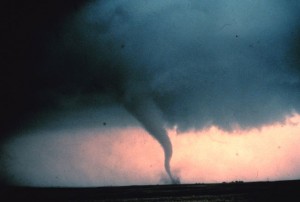
Thunder rolls. The lights go out. Sirens go off. A tornado touches down. And your business is in the path … NOW what do you do? Unfortunately, I can tell you from experience.
Technology professionals talk about disaster recovery and business continuity planning as if there are secret recipes that only we can learn. Complicating the situation more, most small business people are focused on making the business succeed and don’t think they have the time to create a plan. I can tell you from experience: You don’t have time to not build a plan.
A few years back, I was running the IT department for a mid-sized financial services company and had to execute our disaster recovery plan. At 10:00 p.m., our city was hit by a Tornado that touched down taking out over a mile of high-voltage power and its primary substation. This left the community completely without power for three days. Our main office was not damaged, but because we received power from the destroyed grid, that building was out of business. Our tech building, which was literally across the parking lot, still had all the power it needed. Our other locations were also without power. We had no phone, no room for most people to work and the markets would be open in 10 hours! This was not good.
As we got reports of the scope of the problems, I opened up the DR plan (disaster recovery), called my team, and we went to work. Among the things we did were:
• Temporarily brought power from our tech building to our main building.
• Relocated key customer functions into our tech building.
• Gave half the IT team time off to help with recovery efforts (not only did we want to support our employees, their families and the community, we also had no room for them in the building).
• Ensured our key data and systems were up and functioning.
We worked through the night and were able get both buildings functioning by start of business the next day.
Clearly the plan, team and what I had to recover were significantly larger than what most small businesses would have to deal with, but the concepts are identical. Most small businesses that experience an unplanned business interruption are not in business a year later. Every business needs to have a disaster recovery plan. What the plan covers, how detailed it is, and how much time is spent putting it together needs to reflect the needs of the organization. All plans must be written down and stored in more than one place.
The formality of the plan and effort to create it should reflect the organization as a whole. For a small startup with a handful of staff, building a plan could simply be an afternoon on your tablet brainstorming. A mid-size business may have someone spend a few days gathering information and documenting, while a larger organization may need a team with multiple meetings to create a plan.
Having successfully executed a plan, I learned a few things:
• Write down even the wild ideas. Powering one building from the other was initially a joking remark during our planning sessions.
• Include cell phone numbers. A list of contacts and their contact information (home phone, cell phone, street address) is only good if it’s current and accurate. Cell phone numbers may be more valuable if land lines are lost as part of the disaster. Just be aware, that cell phone service could be disrupted, too. That’s where street addresses may help as a last resort for contacting a critical team member.
• Don’t sweat all the details. The plan is a guide to ensure you work through things, not a fully executable set of steps. The details will have to adjust based on the actual situation.
And finally …
• Just Do It. Start with what you can today, and add more details when you can. The plan doesn’t have to be “done” to be useful.
Hopefully my experience will help you prepare. Creating that disaster recovery plan is like buying insurance. You hope you never have to use either one, but if you do, they can be invaluable.
Have you created a disaster recovery plan? Do you have any tips, tricks or resources you can share? Please leave a comment below, add a comment to our Facebook, Google+ or LinkedIn walls or send us a tweet.
